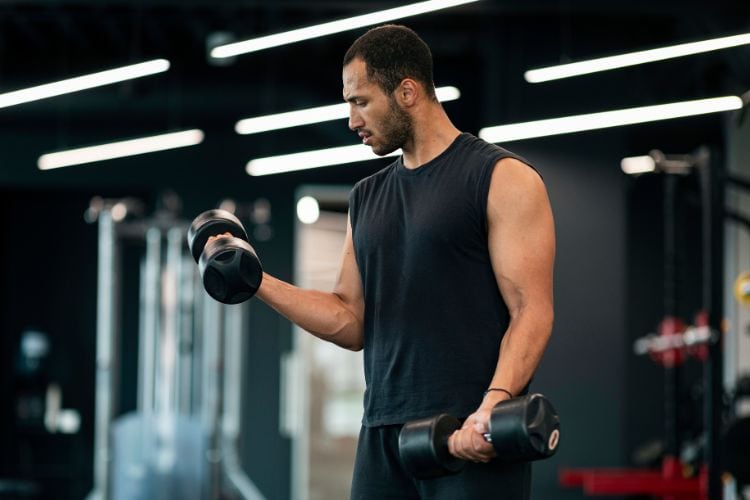
45 Minutes to Fit: A Full-Body Kettlebell Workout for All Levels

40-Minute Full-Body Kettlebell Workout (Build Muscle, Burn Fat)

30-Minute Kettlebell Workout for Total-Body Strength

25-Minute Full Body Kettlebell Workout for Strength & Fat Loss
Best Workout Split for Muscle Gain | Complete Guide

Building muscle effectively requires more than just showing up at the gym and lifting weights. To maximize results, you need a structured training program designed to target all major muscle groups with the right frequency, intensity, and recovery. That’s where workout splits for muscle gain come into play.
A workout split refers to how you divide your training sessions throughout the week to focus on specific muscle groups or training styles. Choosing the best workout split can significantly impact your progress, strength, and overall physique.
In this comprehensive guide, we’ll break down the most effective workout splits for muscle growth, explain the science behind them, and help you decide which plan is best suited to your goals, schedule, and training experience.
Why Workout Splits Matter for Muscle Gain
When it comes to building muscle, training volume (sets × reps × weight), frequency, and intensity all play critical roles. A workout split helps organize these factors so that you:
- Train each muscle group effectively without neglecting smaller stabilizing muscles.
- Balance work and recovery to prevent overtraining and injuries.
- Match your workouts to your lifestyle and schedule for consistency.
- Promote progressive overload — the principle of gradually increasing resistance to stimulate muscle growth.
Without a structured split, you risk random training patterns, uneven muscle development, and slower results.
Factors to Consider When Choosing a Workout Split For Muscle Gain
Not all splits are created equal, and the best one for you depends on several factors:
1. Training Experience
- Beginners often benefit from full-body or upper/lower splits that emphasize frequent practice of key lifts.
- Intermediates can handle more volume and intensity, making push/pull/legs or body-part splits effective.
- Advanced lifters may use specialized splits for lagging muscle groups.
2. Weekly Schedule
Your availability dictates your split. If you can only train three days per week, a full-body or push/pull/legs rotation may work best. With five or six days, more advanced splits are possible.
3. Goals
- Muscle hypertrophy (size): Moderate to high training volume with 8–12 reps per set.
- Strength: Lower reps (3–6) with heavier loads, often integrated into strength-focused splits.
- Endurance/conditioning: Higher reps (15–20) with shorter rest times.
4. Recovery Ability
Your age, sleep quality, stress levels, and nutrition impact how well you recover. Recovery is when actual muscle growth happens, so your split should balance workload and rest.
The Best Workout Splits for Muscle Gain
Let’s explore the most popular and effective splits used by beginners, intermediates, and advanced lifters.
1. Full-Body Workout Split
Overview
A full-body workout targets all major muscle groups in each training session. Typically done 2–4 times per week, this split is efficient, especially for beginners.
Benefits
- Maximizes frequency (each muscle trained multiple times weekly).
- Simplifies planning for those with limited time.
- Great for building foundational strength and form.
Example Full-Body Routine (3 Days per Week)
- Day 1: Squats, Bench Press, Barbell Row, Overhead Press, Pull-Ups, Bicep Curls, Plank.
- Day 2: Deadlifts, Incline Dumbbell Press, Chin-Ups, Bulgarian Split Squat, Dips, Lateral Raises, Hanging Leg Raises.
- Day 3: Front Squats, Weighted Push-Ups, Dumbbell Rows, Military Press, Face Pulls, Tricep Extensions, Ab Rollouts.
2. Upper/Lower Workout Split For Muscle Gain
Overview
The upper/lower split divides training into upper-body days and lower-body days, usually 4 times per week.
Benefits
- Balances volume and recovery.
- Ideal for intermediates looking for more frequency than full-body training.
- Allows progression on compound lifts while adding accessory work.
Example Upper/Lower Routine (4 Days per Week)
- Day 1 – Upper: Bench Press, Pull-Ups, Dumbbell Shoulder Press, Barbell Rows, Skull Crushers, Dumbbell Curls.
- Day 2 – Lower: Deadlifts, Front Squats, Romanian Deadlifts, Calf Raises, Hanging Leg Raises.
- Day 3 – Rest
- Day 4 – Upper: Incline Bench, Chin-Ups, Arnold Press, Face Pulls, Tricep Dips, Hammer Curls.
- Day 5 – Lower: Back Squats, Walking Lunges, Glute Bridges, Leg Press, Weighted Plank.
3. Push/Pull/Legs (PPL) Workout Split For Muscle Gain
Overview
A push/pull/legs split separates exercises into pushing movements, pulling movements, and leg-focused training. Typically done 3–6 times weekly.
Benefits
- Very popular for muscle hypertrophy.
- Provides balanced training for all muscle groups.
- Flexible — can be run as a 3-day or 6-day program.
Example PPL Routine (6 Days per Week)
- Day 1 – Push: Bench Press, Overhead Press, Dips, Incline Dumbbell Press, Lateral Raises, Triceps Pushdowns.
- Day 2 – Pull: Deadlifts, Barbell Rows, Pull-Ups, Face Pulls, Bicep Curls, Shrugs.
- Day 3 – Legs: Squats, Romanian Deadlifts, Bulgarian Split Squats, Calf Raises, Ab Wheel.
- Day 4–6: Repeat Days 1–3.
4. 5-Day Body-Part Split (Bro Split) Muscle Gain Workout
Overview
The “bro split” dedicates one training day per muscle group (e.g., chest, back, legs, shoulders, arms). While often criticized, it remains effective for hypertrophy when volume is sufficient.
Benefits
- High volume per muscle group per session.
- Great for advanced lifters focusing on detail and aesthetics.
- Allows maximum pump and isolation work.
Example Bro Split (5 Days per Week)
- Day 1 – Chest: Bench Press, Incline Dumbbell Press, Chest Fly, Dips, Push-Ups.
- Day 2 – Back: Deadlifts, Pull-Ups, Barbell Rows, Lat Pulldown, Hyperextensions.
- Day 3 – Legs: Squats, Leg Press, Romanian Deadlifts, Calf Raises, Walking Lunges.
- Day 4 – Shoulders: Military Press, Arnold Press, Lateral Raises, Upright Rows, Face Pulls.
- Day 5 – Arms: Barbell Curls, Hammer Curls, Skull Crushers, Tricep Kickbacks, Rope Pushdowns.
5. Hybrid Splits (Upper/Lower + PPL Combination)
Overview
Hybrid splits combine elements of different routines. For example, an upper/lower split for strength with added push/pull/legs focus for hypertrophy.
Benefits
- Maximizes strength and muscle gain simultaneously.
- Reduces monotony by varying weekly structure.
- Perfect for intermediates and advanced lifters.
Advanced Workout Split Considerations for Muscle Gain
Training Volume and Frequency
- Research suggests 10–20 sets per muscle group per week is optimal for hypertrophy.
- Frequency of 2 times per week per muscle group is often superior to once-per-week training.
Progressive Overload
Gradually increase weight, reps, or sets to ensure continuous growth. Sticking to the same weight and reps indefinitely leads to plateaus.
Rest and Recovery
- Muscles grow outside the gym, not during workouts.
- Aim for 7–9 hours of sleep per night.
- Manage stress and prioritize nutrition for recovery.
Nutrition for Muscle Gain
- Protein: 1.6–2.2 g/kg of body weight per day.
- Calories: A small surplus (250–500 calories above maintenance) promotes lean muscle gain.
- Carbs and fats: Balance both for energy and hormone function.
Choosing the Best Workout Split For Muscle Gain for You
The “best” workout split depends on your unique needs:
- Beginners: Full-body or upper/lower split.
- Intermediates: Upper/lower or push/pull/legs.
- Advanced lifters: PPL, bro split, or hybrid routines.
If time is limited, focus on full-body or PPL rotations. If aesthetics are your main goal and you can train five or six days, a bro split or hybrid split may be ideal.
Sample Workout Split For Muscle Gain Weekly Schedules
3-Day Beginner Routine
- Monday: Full-Body A
- Wednesday: Full-Body B
- Friday: Full-Body C
4-Day Intermediate Routine
- Monday: Upper
- Tuesday: Lower
- Thursday: Upper
- Friday: Lower
6-Day Advanced Routine
- Monday: Push
- Tuesday: Pull
- Wednesday: Legs
- Thursday: Push
- Friday: Pull
- Saturday: Legs
Mistakes to Avoid in Workout Splits For Muscle Gain
- Skipping legs: Lower body training boosts testosterone and overall growth.
- Neglecting progressive overload: Growth stalls without increased challenge.
- Overtraining small muscles: Biceps and triceps don’t need 30+ sets weekly.
- Not tracking progress: Keep a training log to measure improvements.
The Best Workout Split for Muscle Gain
There is no universal “perfect” workout split, but there is an optimal split for your body, goals, and lifestyle. Beginners thrive on full-body or upper/lower programs. Intermediates often excel with push/pull/legs splits. Advanced lifters may maximize their results with bro splits or hybrid structures.
The key is consistency, progressive overload, balanced nutrition, and recovery. Choose a split you can realistically maintain, and you’ll see steady muscle gain over time.
Most Recommended
Subscribe to our Newsletter
Stay up to date on the latest men’s health, fitness and lifestyle trends and tips.
About Us
Men’s Fit Club was started with the goal of empowering men to get the most out of their lives. This meant going beyond exercise and diet tips to really address the broad range of issues that men face on a daily basis – topics like recreation, finding love, sexual health and even sound fashion advice.
Quick Links
© COPYRIGHT MEN'S FIT CLUB 2025. All Rights Reserved

